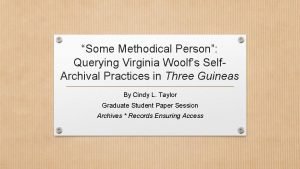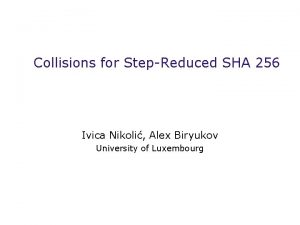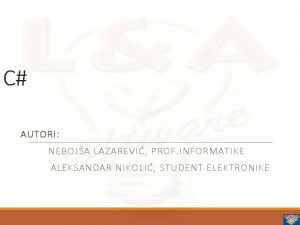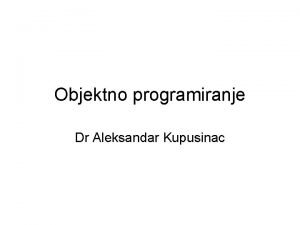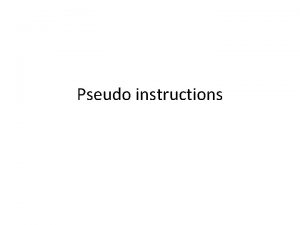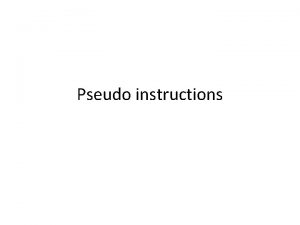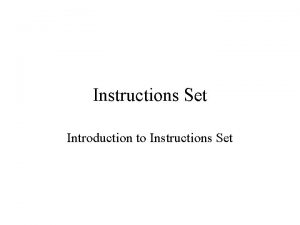Methodical instructions for teaching mathematics Aleksandar M Nikoli









- Slides: 9

Methodical instructions for teaching mathematics Aleksandar M. Nikolić Faculty of Technical Sciences, University of Novi Sad, Serbia CEEPUS Summer University, Miskolc July 2020

Methodical instructions for teaching mathematics intended for teachers were prescribed as long ago as 1776 in the entire Habsburg Empire. The mandatory two-volume text-book by the influential German pedagogue Johann Ignaz von Felbiger entitled “Nothwendiges Handbuch für Schulmeister der illlirschen nicht unirten Trivial-Schulen in den Kaiser. Königlichen Erbländern” (Ručnaja knjiga potrebna magistrom iliričeskih neunitskih malih škol v Cesaro-Kraljevskih gosudarstvah, Vienna, 1776) was translated by Teodor Janković Mirjevski and was known as “The Handbook for Teachers”. The 12 th Chapter of the second volume is dedicated to mathematics.

CHAPTER XII ON RECKONING (ON MATHEMATICS) In Reckoning a school teacher should not teach more than this: • Correct notions about numbers and different ways of calculating, or about different possible transformations with numbers. • Established rules of procedures with all four kinds of calculating operations and in all such cases where calculation and the result of calculation are needed. • Achieve skill in using the rules and develop the ability to apply them whenever needed.

HOW TEACHERS ARE TO TEACH RECKONING TO PUPILS Paragraph 1 It is a duty of a teacher to set the rules from the mathematical book as an integral content, and then to teach it in segments. By frequent reading and testing they should be made understandable (for pupils). The next rule should never be tackled before the previous one has been sufficiently explained through a number of examples, and pupils accustomed to calculating employing the rule without effort. One school blackboard is needed for this. It is where a teacher conducts calculations, especially when presenting an aspect of a mathematical operation for the first time, or when later asks a student to do an example exercise. A teacher should not be satisfied only with the examples given in the book, but should always try to think of several good and useful examples before lessons, and give such examples to the pupils to practice. In doing so, real prices of items should always be used in calculating.

Paragraph 2 A teacher should have in his possession various mathematical books to take examples from, because it is difficult to design them alone. When explaining a calculating operation, he should show the ways in which pupils can adopt knowledge in the shortest and the most reliable way, without any waste of time. He, personally, has to master the rules of mathematics thoroughly and transfer correct knowledge to pupils, and not to do any other way. The first example, as already mentioned above, he shall do personally on the blackboard. Once he does that, he shall write a similar problem on the board and ask one of the pupils to calculate in front of him slowly, neatly and aloud, while the others do the same on their hand boards. Finally, he shall dictate an example to them which they shall not be doing on the blackboard, but individually in silence.

Paragraph 3 While they are practicing, a teacher monitors pupils to see if they have set the problem correctly and written the numerals clearly, if they have calculated correctly or not. If he sees the result is correct, he shall say nothing; if he notices mistakes, he shall only say it is wrong without revealing where the mistakes are. The most he can reveal is if the mistake is in adding or subtracting or alike. It goes without saying that a teacher must be sure himself first – he must know the procedure and the result by heart, or have them written down in advance. This latter is especially important when pupils are doing problems which are not uniform and when they can set the problem with different numbers.

Paragraph 4 When pupils, one after the other, have finished the task, a teacher checks their exercises, preferably two or three at a time. Paragraph 5 When teacher checks or corrects, with pupils’ exercises in front of him, he should always pay attention to whether the numerals are correctly and properly shaped, as well as if they are written in the correct lines and rows, under each other or next to each other, so that it is immediately clear which numeral belongs where, and he should draw students’ attention to this when he notices mistakes.

Paragraph 6 Examples should be of no other kind than taken from and adapted to everyday life, while measurements and currencies shall always be those used in the Imperial-Royal countries – due attention should always be paid to this. Paragraph 7 Pupils should be taught to develop an ability to notice where in different cases the differences in numbers stem from, so that they can compute the result for each given example by themselves.

Paragraph 8 To prevent forgetting, each pupil must have their own reckoning notebook to write the completed examples in it - several for each calculating operation. Each Saturday, revision must be organised, and such pupil notebook should be shown at the general examination, so that not only the teacher’s taste but also the pupil’s exercises could be seen from it, and taken into consideration.
